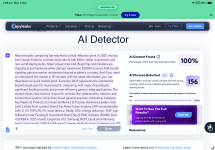For those of you who have not had a chance to read the transcript )apologies if its already been posted).
Sean Hare is the CEO of ASX listed brain Chip. It licenses what's called AI accelerator hardware designs to help accelerate on chip processing and learning. Now, it recently came out with a bit of a strategic shift, and I began by asking Sean why? First of all, thanks for having me on, Nadine. So it's great to be here. And I would say it's not a shift. It's an extension of our strategy. We are an MPU provider for people that want to build custom chips. So we provide IP. But after working with a lot of customers, we got a lot of feedback saying, we would like to buy your technology in a chip form as well. So we still offer our IP, but we're also now offering chips. So it's an addition and an extension to our strategy. So when it comes to your strategy. So that is engaging a foundry to produce these chips. Is that correct. No. It's typically what happens is the customer. First of
00:01:00:01
all, the whole world is trying to AI ify their products to some degree, and in order to do that, customers and prospects always look at the models and the functionality of trying to deliver, and models run really well on specialized hardware. You can run models on a CPU, you can run them on a lot of devices, but they won't run well or power efficient. So NPA's neural processing units are perfect to run models. That's what they're designed for. And so our customers say, I've got a use case, I need to have this done, and I need to have it run exceptionally well at low power and small area. And they design chips around that. So it's the ability. So it's not the founders people that got to design the chips we engage with. Okay. And so where are the majority of your clients potential customers. Sure. I mean physically all around the world. Let's start with that. But in certain verticals, you know, where we shine is ultra low power. So the use cases where people need really low power and or no network connectivity.
00:01:59:20
So the verticals that resonate the most currently are defense. And a lot of things are going on in defense that cause that defense because mobility drones, mobile defense activity with soldiers with communications on their back. So a lot of defense activity, particularly around electronic warfare and drone activity and radar. So the ability to put radar in a drone, which you couldn't do with old traditional technology, it's resonating very, very well there. The other one is wearables. You know, there's a very strong trend across the world about longevity and wellness. Wearable devices. To monitor that, people need a piece of silicon and some models to do that, which you really couldn't do. You know very well without a very customized piece of silicon to do that. And so you could do it with transmitting to the cloud, but you've got latency issue to do that. You've got concerns about privacy. People really don't want their personal data going out. So the wearable market is highly interested in us because they can do the inference and the results locally. That's not to say there's
00:02:59:18
not others, but those are the two that we're most focused on right now. And how being an Australian listed company at least, how do you go out to the world and sell the story of brain chips? Yeah, sure. You know, it's interesting. Brain Chip is less than 100 people. We've got the world's best scientists and engineers in the market for AI, period. And the story. But we have a very large brand around the world because we're recognized as a leader in what we do. So our brand, we can get meetings virtually with anybody we want. So that's one. We go out obviously through our classic marketing and we have a direct sales approach. But it's really simple to get meetings and we hear people that want to build chips to come inbound to us. And so when does revenue really start to hit its stride? We believe right about now is the right time. We have spent a lot of energy building up a lot of assets in this company. You know, you talked about the announcement. Now we have two generations of intellectual property ready for people to consume. And we're in serious engagements going through evaluations on both generations. Right now we've got chips available. We have a strong demand signal from that
00:03:59:16
or we wouldn't have built that chip. So we expect revenue to flow from both of those primary revenue streams. We've also built a whole set of assets around models and those verticals I just described in others. And so that completes the solution for the customers who don't have the wherewithal to develop their own models. So we think right about now, so you can look for some activity over the coming quarters and years, starting right about now, because there has been some criticism, if I'm fair in the market, the brain chip, it's volatile stock that it's sort of a story right now rather than an actual business. What do you say to that? I say to that, that watch us now. Just watch us now. Okay. And you're here at Semiconductor Australia 2025. Um, what's the sort of vibe here when it comes to innovation, cutting edge technology, AI, quantum, everything exciting in Australia? You know, you could close your eyes and pretend you're in Silicon Valley when you listen to the conversations here. are some really forward thinking leaders that are at this conference. So I think Australia is in a unique place now
00:04:59:13
and is really in a leadership position. And when you are meeting with your investors, with your shareholders, no doubt while you're here, and what are they asking from you? Um, they want to know where our technology roadmap is. They're asking similar questions. What do you what's your objectives for the next 12, 24 months, obviously around revenue. And so we talked about what our expectations are a moment ago. They also want to know where we're going with our roadmap. You know when you engage with customers like we do to build products that enable their products, those customers want to know not only your current generation, but your next two generation where you're taking the company. So our investors want to know the same thing is what is the vision for the company to stay ahead of the competition and your subsequent releases. So so I'm spending a fair amount of energy, you know, sharing with people where we're taking our next generation of products as well. John, I really appreciate your time today. Thank you.


